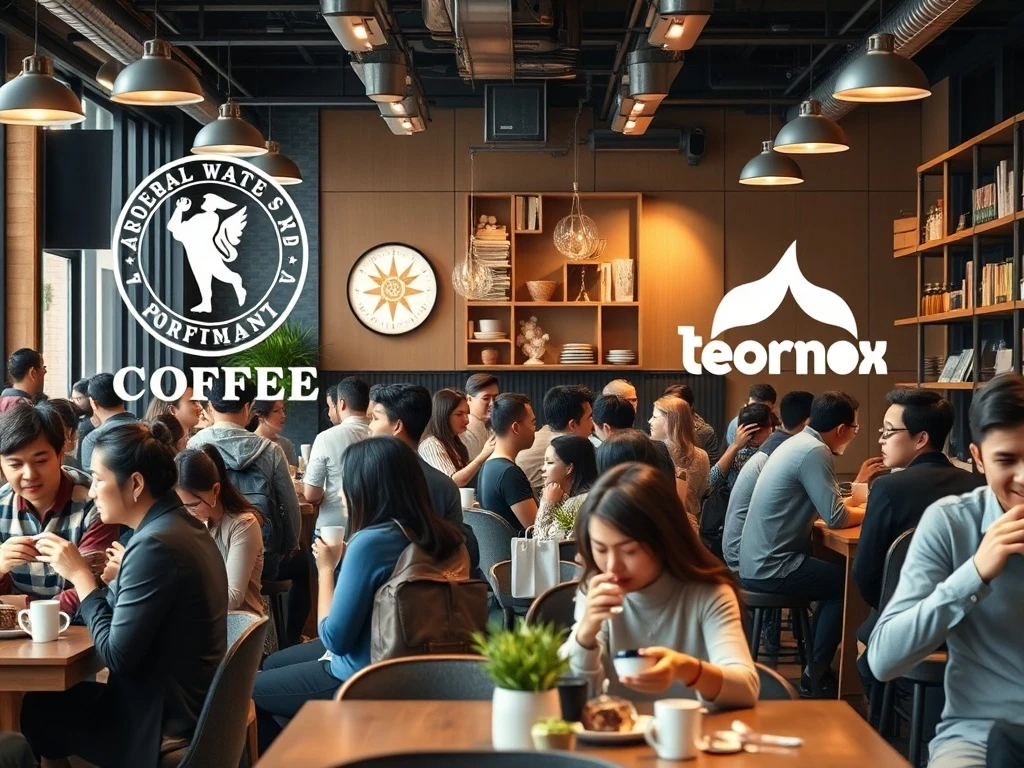The global coffee industry is witnessing a significant shift. For decades, Starbucks has stood as an undisputed titan, shaping coffee culture worldwide. However, the landscape is rapidly evolving. A new wave of agile, fast-growing rivals now actively challenges its long-held dominance. This intensifying Coffee Market Competition signals a pivotal moment for established players and newcomers alike. Businesses must adapt quickly to maintain their standing.
Understanding the Evolving Coffee Market Competition
The global coffee market continues its robust expansion. Consumers increasingly seek diverse coffee experiences. This demand fuels growth but also intensifies competition. New brands emerge, often focusing on niche segments or innovative business models. Consequently, they carve out significant market shares. This dynamic environment means no single player can rest on past laurels. Understanding these shifts is crucial for all stakeholders.
Several factors contribute to this heightened Coffee Market Competition:
- Changing Consumer Preferences: Younger generations prioritize sustainability, ethical sourcing, and unique flavor profiles.
- Technological Advancements: Mobile ordering, delivery services, and AI-driven personalization redefine convenience.
- Lower Barriers to Entry: Online platforms and direct-to-consumer models enable smaller brands to scale rapidly.
- Specialty Coffee Boom: A growing appreciation for artisanal and single-origin coffees creates new market segments.
Ultimately, these elements combine to create a fiercely competitive arena. Every company must innovate constantly to attract and retain customers.
Starbucks’ Position Amidst Rising Rivals
Starbucks built its empire on consistency, brand recognition, and a ubiquitous presence. Its vast network of stores, premium pricing, and comfortable ‘third place’ atmosphere have long been its hallmarks. However, these very strengths now face scrutiny. Many emerging competitors offer alternative value propositions. Therefore, Starbucks must strategically respond to these pressures.
For instance, some rivals focus heavily on price, undercutting Starbucks’ premium offerings. Others emphasize speed and convenience, appealing to on-the-go consumers. Moreover, a significant number of new entrants champion sustainability and direct trade, resonating deeply with environmentally conscious buyers. This diverse competitive landscape forces Starbucks to re-evaluate its core strategies. It must consider how to best serve its loyal customer base while attracting new demographics. The ongoing Coffee Market Competition demands agility from even the largest players.
The Strategies of Fast-Growing Coffee Rivals
The rapid ascent of new coffee brands is not accidental. These companies employ distinct strategies that differentiate them from traditional giants. Firstly, many leverage technology extensively. They offer seamless mobile ordering, personalized loyalty programs, and efficient delivery networks. Secondly, they often prioritize sustainability and ethical sourcing. This appeals strongly to a growing segment of consumers. Thirdly, they cultivate unique brand identities, often focusing on a specific aesthetic or community feel.
Consider the rise of drive-thru-only chains, for example. These businesses optimize for speed and efficiency, catering to commuters. Similarly, numerous independent roasters emphasize the craft of coffee-making, attracting connoisseurs. Furthermore, subscription services deliver fresh beans directly to consumers’ homes, offering unparalleled convenience. These varied approaches highlight the multifaceted nature of current Coffee Market Competition. Each new entrant aims to capture a specific segment of the market, thereby chipping away at the dominance of established players.
Digital Innovation and Customer Engagement
Digital platforms are central to the success of many fast-growing coffee rivals. These companies utilize apps for ordering, payment, and loyalty points. They also engage customers through social media, building strong online communities. This digital-first approach reduces overhead costs associated with physical locations. It also allows for highly targeted marketing campaigns. Consequently, they can reach specific demographics with greater precision.
Moreover, data analytics plays a crucial role. Rivals analyze purchasing patterns to offer personalized recommendations and promotions. This enhances the customer experience significantly. It also fosters a sense of loyalty among patrons. Ultimately, by mastering digital engagement, these new players create a formidable challenge in the ongoing Coffee Market Competition. They demonstrate that convenience and personalization are increasingly paramount for modern consumers.
Sustainability and Ethical Sourcing as Differentiators
Consumers are increasingly conscious of the environmental and social impact of their purchases. Fast-growing coffee rivals have effectively capitalized on this trend. They often highlight their commitment to fair trade practices, sustainable farming, and eco-friendly packaging. This resonates deeply with a demographic willing to pay a premium for ethically produced goods. Such transparency builds trust and brand loyalty.
For example, many brands partner directly with coffee farmers, ensuring fair wages and sustainable agricultural methods. Others invest in compostable cups or reusable container programs. These initiatives not only appeal to consumers but also contribute positively to the brand’s image. In essence, sustainability has become a powerful differentiator in the intense Coffee Market Competition. It allows newer brands to stand out from larger, more established chains.
Starbucks’ Response to the Shifting Landscape
Starbucks is not oblivious to these challenges. The company has initiated several strategic moves to counter the rising Coffee Market Competition. It has invested heavily in its digital presence, enhancing its mobile app and expanding delivery options. Starbucks also introduced new store formats, including smaller express stores and pick-up-only locations, to improve convenience. Furthermore, it has diversified its menu, adding plant-based options and unique seasonal beverages.
Additionally, Starbucks has increased its focus on sustainability initiatives. It aims to reduce its environmental footprint through various programs, including waste reduction and sustainable sourcing. The company also continues to innovate with new coffee blends and brewing methods. These efforts demonstrate Starbucks’ commitment to adapting to changing consumer demands and competitive pressures. However, the sheer scale of its operations makes rapid pivots challenging. Maintaining its market position requires continuous innovation and responsiveness.
Innovation in Products and Store Formats
To stay ahead, Starbucks has focused on product innovation. It regularly introduces new drinks and food items, keeping its menu fresh and exciting. This strategy aims to drive repeat visits and attract new customers. Moreover, the company experiments with different store designs. These include smaller ‘Starbucks Pickup’ locations in urban centers, designed for speed and efficiency. These formats directly address the convenience factor that many rivals emphasize.
Furthermore, Starbucks explores concepts like Reserve Roasteries, offering an elevated, immersive coffee experience. These larger, more elaborate locations showcase the artistry of coffee and provide a unique draw. Such varied approaches to product and store design reflect Starbucks’ comprehensive strategy to navigate the fierce Coffee Market Competition. They seek to cater to diverse customer needs, from quick grab-and-go options to premium, experiential visits.
Expanding Digital Reach and Loyalty Programs
Starbucks’ digital transformation remains a key pillar of its strategy. The Starbucks Rewards program is a highly successful loyalty initiative. It encourages frequent visits and offers personalized promotions. The company continuously enhances its mobile app, making ordering and payment seamless. This digital ecosystem fosters strong customer engagement and reduces wait times. Consequently, it improves the overall customer experience.
Moreover, Starbucks has expanded its delivery partnerships, making its products accessible through various third-party platforms. This broadens its reach significantly. It also caters to the growing demand for home delivery services. By prioritizing digital innovation, Starbucks aims to maintain its competitive edge. This robust digital infrastructure is crucial for navigating the evolving dynamics of Coffee Market Competition and retaining its vast customer base.
The Future of Coffee Market Competition
The future of the coffee market promises continued dynamism. Expect more consolidation among smaller brands and increased diversification from major players. Technology will undoubtedly play an even larger role, from AI-driven personalization to blockchain-based supply chain transparency. Sustainability will transition from a differentiator to a baseline expectation. Consumers will increasingly demand ethically sourced and environmentally friendly products.
Furthermore, the line between coffee shops, cafes, and even grocery stores will blur. Hybrid models offering unique combinations of products and services will emerge. Ultimately, success in this environment will hinge on agility, innovation, and a deep understanding of evolving consumer values. The ongoing Coffee Market Competition will compel all participants to continually redefine their offerings. Only those who adapt effectively will thrive in this challenging landscape.
In conclusion, while Starbucks remains a dominant force, the escalating Coffee Market Competition presents significant challenges. Fast-growing rivals, armed with digital prowess, sustainability commitments, and innovative business models, are reshaping consumer expectations. Starbucks’ strategic responses, including digital expansion, product innovation, and new store formats, are vital. The global coffee industry will undoubtedly continue to brew new opportunities and challenges for all players involved.
Frequently Asked Questions (FAQs)
What is driving the increased Coffee Market Competition?
The increased Coffee Market Competition is driven by several factors. These include changing consumer preferences towards sustainability and unique experiences, advancements in technology like mobile ordering, lower barriers to entry for new brands, and the booming popularity of specialty coffee. These elements together create a highly dynamic and competitive environment for all coffee businesses.
How are fast-growing coffee rivals challenging Starbucks?
Fast-growing coffee rivals challenge Starbucks by focusing on specific niche markets, leveraging advanced digital technologies for convenience, emphasizing strong sustainability and ethical sourcing practices, and offering unique brand experiences. They often provide more personalized services or cater to specific values that resonate with modern consumers, thereby capturing market share.
What strategies is Starbucks employing to maintain its dominance?
Starbucks is employing several strategies to maintain its dominance. These include significant investments in its digital platforms and loyalty programs, expanding delivery options, introducing new and diverse store formats (like express and pick-up only locations), diversifying its menu with new products and plant-based options, and enhancing its commitment to sustainability initiatives.
Will Starbucks lose its market leadership due to competition?
While the Coffee Market Competition is intensifying, it is unlikely that Starbucks will completely lose its market leadership in the short term. Its strong brand recognition, vast global presence, and loyal customer base provide a significant advantage. However, it will need to continuously innovate and adapt to consumer trends and competitive pressures to maintain its dominant position in the long run.
What role does sustainability play in the current coffee market?
Sustainability plays a crucial and growing role in the current coffee market. Consumers increasingly prioritize ethically sourced, environmentally friendly products. Many fast-growing coffee rivals use sustainability as a key differentiator, highlighting fair trade practices, eco-friendly packaging, and responsible sourcing. This trend influences purchasing decisions and forces all players, including Starbucks, to enhance their sustainability efforts.
How does technology impact Coffee Market Competition?
Technology significantly impacts Coffee Market Competition by enabling new business models and enhancing customer experiences. Mobile ordering apps, delivery services, personalized loyalty programs, and data analytics allow brands to offer greater convenience and tailored services. This digital transformation lowers barriers to entry for new competitors and pushes established players to invest heavily in their tech infrastructure to remain competitive.
























